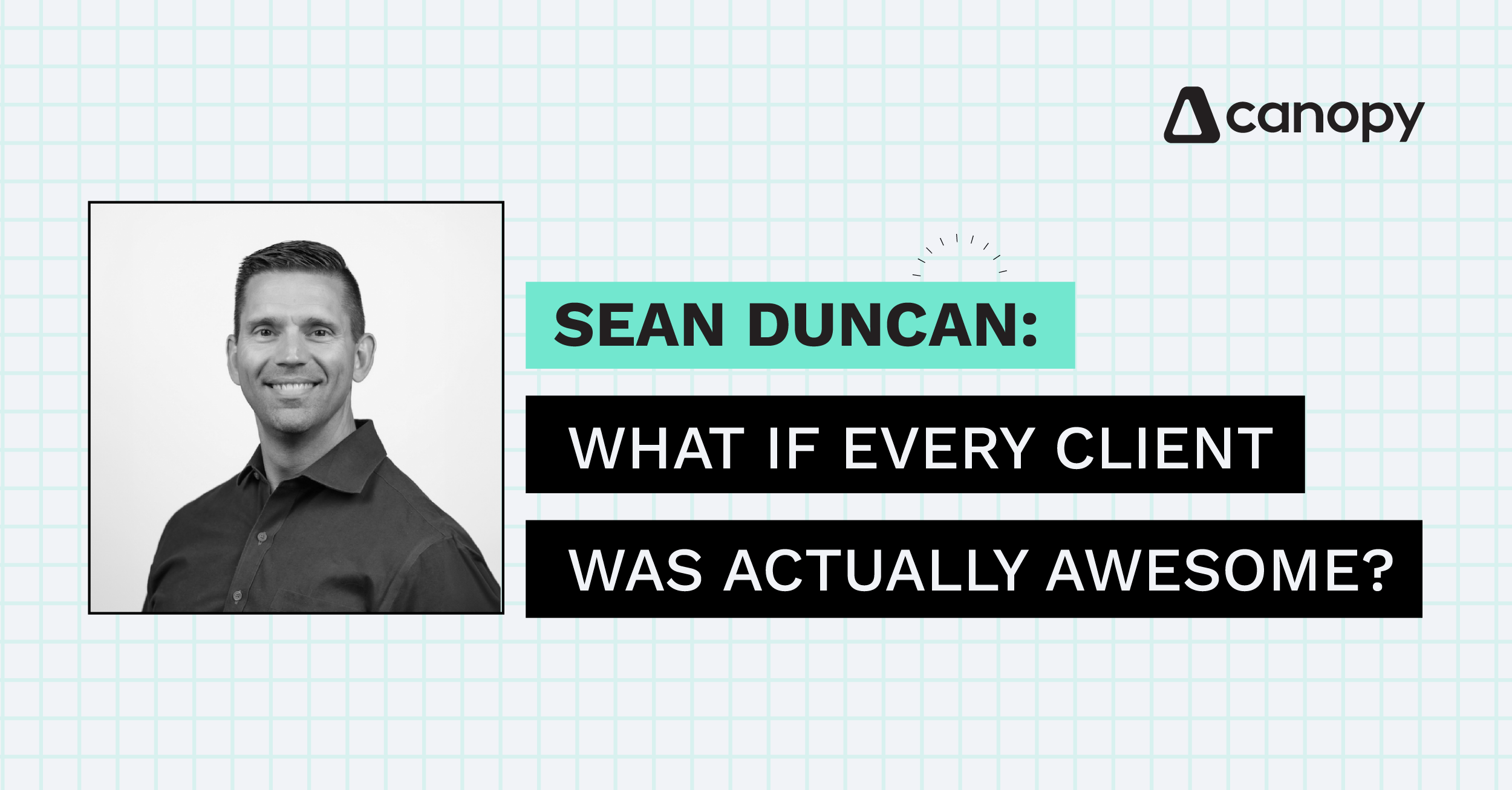Imagine this for a second: every client you work with is a dream. Like, actually a dream.
- They’re kind.
- They pay on time.
- They’re in an industry that lights you up.
- They respect your expertise, your time, and your boundaries.
- Something else?
You look at your calendar and think, “I can’t believe I get paid to do this.”
(Don’t worry, you still get to complain about emails. We’re not animals.)
Now ask yourself: what kind of impact would that have? Not just on your revenue — though spoiler alert, you’d probably make more — but on your sanity?
- Would you be more profitable?
- More efficient?
- Less burned out?
- More likely to still be doing this in five years with your soul intact?
Here’s the reality check: most of us didn’t get into our own practice just to feel trapped by it.
And yet, way too often, we find ourselves working with clients who just aren’t a good fit. Not because they’re bad people (okay, sometimes they are), but because they’re not aligned with how we want to work or who we’re best equipped to serve.
Why does this happen?
In my experience — and I’ve seen this over and over again — it usually comes down to a lack of clarity. We haven’t clearly defined who we actually want to work with. And when that clarity is missing, our revenue goals start driving the bus. We say yes to everyone. We rationalize. We think, “It’s just this one client,” until suddenly… It’s most of them.
But here’s the good news: You can define your ideal client — and when you do, it becomes one of the most powerful tools in your business.
Whether you’re just starting your firm or scaling like a beast, getting intentional about who you want to serve helps you attract more of the right people, and gently repel the ones who will drain your energy and your margins.
And guess what? Your ideal client profile isn’t set in stone. As your expertise evolves and your offerings adapt to client needs & economic changes, so should your client filter. Refining your niche is part of the growth.
In fact, at SMD Consulting & Accounting, LLC, we’ve built an internal tool to help us define exactly who we want to serve — both at a general level and within specific niches.
Here’s a quick preview of how we break it down:
Short Description:
Household Income*:
Age:
Key Industries:
Locations:
I put a little asterisk next to household income because we look at the family that we are helping and not just the business. Because so many of our strategies revolve around flow through entities, AND we involve wealth management in our offering, we have to look at the full picture to give proper advice. You, however, may choose to only support a business, an individual, etc, and that’s completely cool. I just wanted to pop in and interrupt this regularly scheduled program to point out that little nuance that can shift your perspective considerably.
And now BACK to our show! (*In my best TV Voice*)
When we do this, we have two versions. One overall definition of a good client, and then we defined two more specific definitions of what our niche clients look like.
I’m not going to pad this blog with too much content, so let’s just share one example for ya. Here’s an example of one of our niche client definitions using the template:
Short Description: Medical Practice Owner(s)
Household Income*: $300,000-$3,000,000
Age: 30-60
Key Industries: Orthopedic Surgeon, Anesthesiologists, Cardiologist, Plastic Surgeon, Pain Docs, ER Physician, Heart Surgeon, Neurosurgeon, Oral Surgeon, Oncologist, Dermatologist, Radiologist
NOT Interested in: Chiropractors, Psychiatrists, Internal Medicine, General Practitioners, Counselors, Allergist, Pediatricians, Dentists, Geriatrics
Locations:
1) Texas
2) Colorado, Florida, Georgia, Arizona, Tennessee, Oklahoma, Washington, Nevada
2) National
Remember… YOU define what’s important to you and your firm. Steal my examples or scoff at them. My firm is totally different than yours, so it would make a TON of sense that they wouldn’t match up. Be creative! Think about what really jazzes you about certain clients and make that part of the profile. Those friggin awesome people ARE out there.
Keep in mind… These aren’t just “nice to have.” Items…they’re filters we use when onboarding, marketing, and even reviewing our current book of business.
So you have defined your ideal clients… now what?!
Alright, so you’ve defined your ideal client — gold star for that. Now comes the slightly messier part: figuring out what the heck to do with everyone else.
Let’s start with your current roster. Because here’s the thing — just because a client doesn’t check every single “ideal” box doesn’t automatically mean you need to show them the door. It just means they’re not ideal. That’s it. It’s not a crime. But it is a signal that you need to make a conscious decision about their place in your firm.
Now, yes, in some cases, you’ll need to make the tough (but necessary) call to part ways. Some clients are “high maintenance, low margin,” or what I lovingly refer to as:
TIME VAMPIRES (This is where you start your “Mua-hahahah” laugh).
They just continue to suck the life (and hours) out of you and your day... and somehow still question the invoice.
You know the ones. The folks who, despite your best boundaries and processes, still manage to be a full-time job. If they don’t respect your team, your time, or your expertise — this is your permission slip to let them go. You’re not running a rehab center for red-flag clients.
But here’s where it gets tricky. What about the ones that aren’t overt nightmares, but still don’t really fit? The ones who aren’t profitable, or require too much follow-up, or just create friction in your workflow?
This is where you need to be ruthlessly honest. Building a firm you’re proud of means working with clients who align with your values and your business model. It doesn’t mean torching 30% of your revenue overnight in a glorious "I’m reclaiming my time!" frenzy. It means being intentional. Have a plan. Maybe you phase them out — for every new client who is ideal, you let go of one who isn’t. You’ll thank yourself later.
And then there’s this: some clients won’t fit your ideal on paper, but they’re still awesome.
Maybe they’re in a random industry, but they’re delightful humans. Maybe they’re legacy clients who’ve grown with you. Maybe they’re just so kind and appreciative that they bring cookies to your team every quarter. (Yes, I’ve kept clients over baked goods. I have no regrets.)
If they’re a net positive — and they don’t hold you back from reaching the kind of firm you want to build — then keep them! Who says you can’t have a little flexibility in your definition of “ideal”? Heck, maybe they are ideal, and you just need to create a new profile to capture why they’re so great.
Once you’ve made decisions about your current book of business, that clarity gives you fuel for how to move forward. And now comes the marketing part. Except — full disclosure — this is not that blog. I’m still just a CPA, folks. For marketing funnels, SEO tips, and hashtag everything, talk to a specialist who does that kinda stuff for a living. And for the love of all that is holy, don’t rely on TikTok to learn how to market either. Just like you are a professional with expertise, there are marketing folks out there who are as well.
That said…if you catch me at a conference and ask nicely, I’ve got some battle-tested tips and horrible failures that I’ll gladly share over a drink (or baked good, of course).
But here’s what I can tell you: Once you know who you want to attract, every piece of your messaging should be speaking to them. Not the generic masses. Not your Aunt Susan’s cousin who runs a koi pond cleaning business. Just. Them.
And please — I’m begging you — stop following up your niche pitch with “but we also help other businesses too, so if you know anyone…”
Smack! ← that was me slapping your hand.
Every time you dilute your message, you dilute your growth. You are not desperate. You do not need to throw a wide net. You need to throw a precise one. Otherwise, you’re just creating future headaches and awkward offboarding conversations.
Your website. Your elevator pitch. Your social content. Your SEO keywords. Your email signature. All of it should scream: “We help this kind of client solve these kinds of problems.”
When you commit to that clarity, two things will happen — slowly, but surely:
1. You’ll start attracting the exact kind of people you want to work with.
2. Those people will refer other people just like them.
Professionals in your network will know exactly who to send your way. Your reputation will start doing the heavy lifting. And over time, you’ll wake up in a firm full of dream clients — the kind that make you wonder why you didn’t do this years ago.
Bonus prize!
Here’s a cool little side effect we’ve discovered — both in our own firm and in the firms we’ve coached: The more you work with a specific kind of client, the better you get at helping that kind of client. Like, exponentially better.
You start to become a true specialist — not just in tax or accounting, but in their world. You understand their pain points before they even say them out loud. You know which tech stack they need to streamline operations, where the inefficiencies hide, and what “normal” benchmarks look like in their niche. You even start building out custom best practices within your own internal systems — like how their chart of accounts should be structured, or how to tweak payroll workflows to match their cash flow cycles.
And then — if you’re feeling a little frisky — you might just find yourself on a stage at their industry conference, or being asked to lead a webinar for their trade association.
Now imagine what that kind of visibility does for your pipeline.
(Hint: it explodes. In a good way.)
That’s the power of clarity. When you commit to serving a specific type of client — and serving them really well — you start opening doors that you didn’t even know were there. Your expertise deepens, your referrals get sharper, your processes get leaner, and suddenly your business isn’t just growing…it’s compounding.
But it all starts with those first few steps:
- Define who you want to serve.
- Get honest about who’s not a fit.
- Align your message with your mission.
- Then do the work and let momentum build.
Your future self — the one working with awesome clients, speaking at industry events, and finally taking a real vacation — will be very proud of the choices you’re making right now.

Sean M Duncan, CPA, is the President and Founder of SMD Consulting & Accounting, LLC, Chief Proactive Advisors, LLC, and Helping Hand RIA, LLC. SMD Consulting & Accounting, LLC has gained national recognition as an advisory-focused CPA firm specializing in fixed-fee project and subscription services to help business owners and individuals with tax reduction, asset protection, wealth accumulation, and success on their terms. As the "Chief Proactive Advisor," Sean leverages his experiences from creating an advisory firm and helps fellow professionals transition from a reactive to a proactive approach. His methodology accelerates the building of more lucrative and fulfilling advisory practices. His 6-step transformative framework was developed over his 25+ years in the profession.
READ MORE BY Sean






Get Our Latest Updates and News by Subscribing.
Join our email list for offers, and industry leading articles and content.